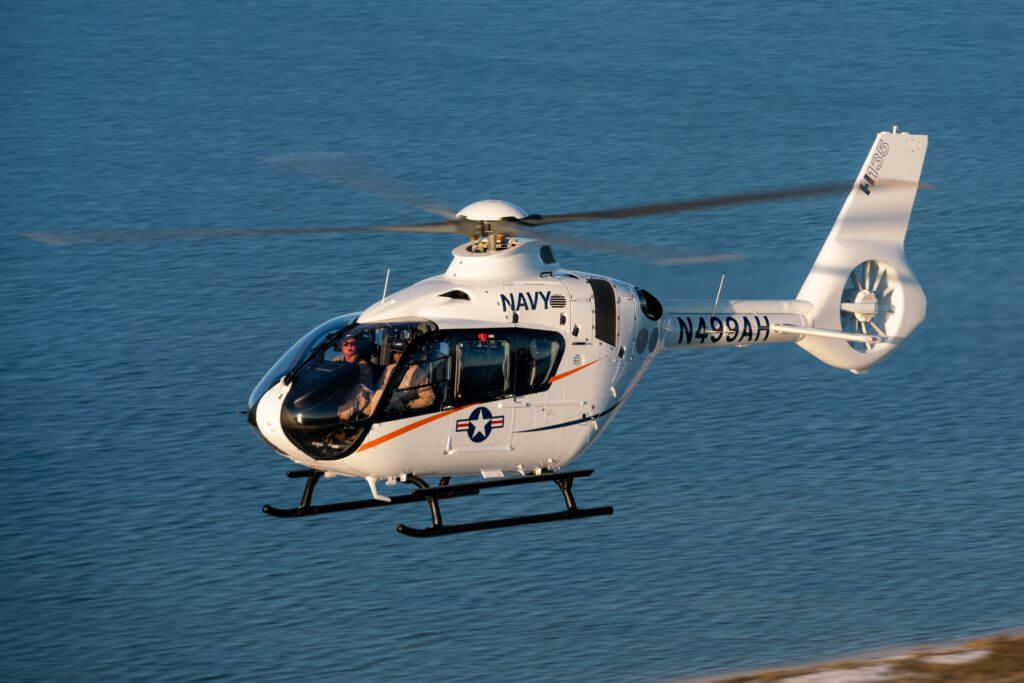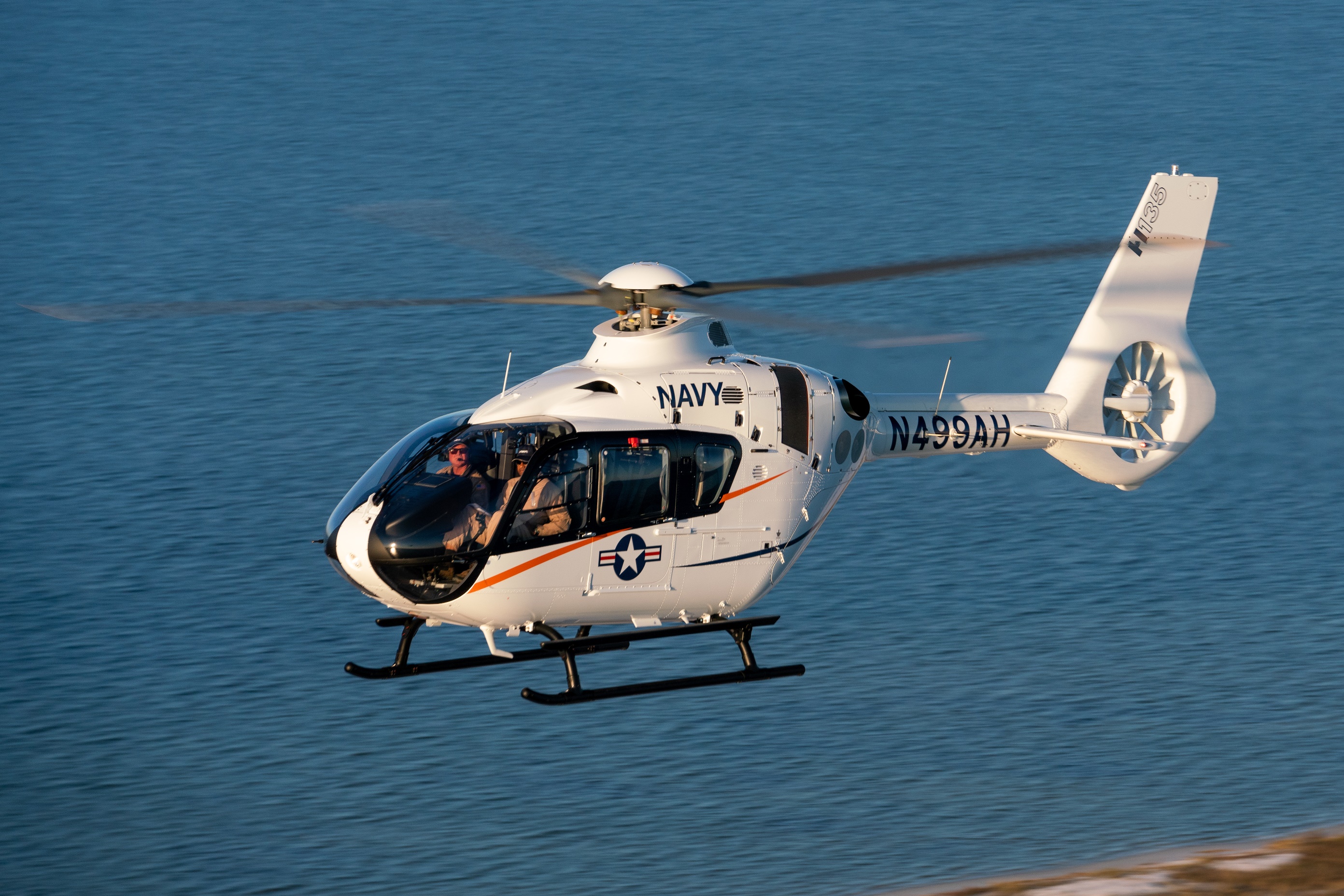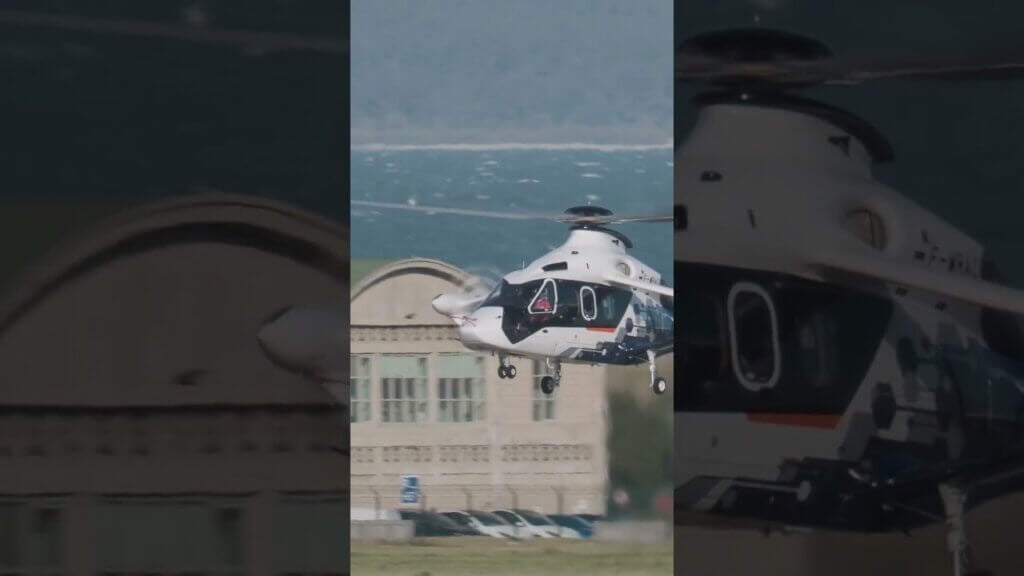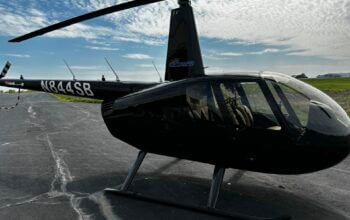Airbus Helicopters is pitching its H135 light twin as the lowest risk solution to the U.S. Navy’s helicopter trainer replacement program.

If chosen, the H135 would provide the Navy with a twin-engine training aircraft that has a modern glass cockpit, four-axis autopilot, integrated flight management system, and is certified for instrument flight rules (IFR) operation. While such a twin-engine platform would clearly not be cheap, Airbus believes the aircraft’s maturity and competitive lifecycle costs will prove appealing to the Navy following a request for proposals that prioritizes technical capability over price.
As detailed in the RFP issued Jan. 28, the Navy is looking for a fleet of 130 helicopters for initial rotary-wing training to replace its aging fleet of Bell TH-57 Sea Rangers, which were originally fielded in the 1970s.
The TH-57 currently serves to bridge Navy rotary-wing pilots from initial flight training in the fixed-wing Beechcraft T-6B to the Navy’s fleet rotary-wing aircraft, the Sikorsky MH-60 Seahawk.
“Where we see an advanced value proposition with an advance trainer like the H135 is an opportunity to kind of keep that steady build-up of skills . . . by moving from the TH-6 and maintaining the glass cockpit, [having an ] introduction to an advanced autopilot and the twin engine skills that translate to the fleet aircraft,” said Scott Tumpak, head of military programs in North America for Airbus.
Airbus believes the Navy is “engine agnostic” in regards to a preference between single and twin. Competitors may point to the cost of a twin, but Airbus is touting potential cost-saving in the ability to “download” hours from from initial training in the fleet aircraft. The manufacturer argues that gaining initial experience in a twin-engine aircraft with a glass cockpit will save hours in a considerably more expensive to operate MH-60.
“What we’ve seen on Lakota with the U.S. Army and other places around the world is the benefit of training like you fight,” said Tumpak. “And the U.S. inventory, whether the Army or the Navy, the [fleet] aircraft are all twin engine, and it makes sense to have a twin-engine trainer.”
One of the Navy’s key requirements for the new trainer is that it must be instrument flight rules (IFR)-capable. This is an area where Airbus believes it has an advantage over Leonardo’s proposed TH-119 (based on the AW119), which is yet to receive IFR certification.
“We obviously have an extremely mature aircraft in terms of IFR with zero development,” said Tumpak.
The Navy has established the trainer replacement program, known officially as the Advanced Helicopter Training System (AHTS), as a “best value” competition.
The service will be using Conklin & de Decker as a reference for lifecycle costs for the competition, and according to Airbus, the H135 will be “far cheaper” than the AW119.
Responses to the RFP are due by April 2, and a rapid program progression will see a contract award in October or November 2019, with deliveries set to begin by September 2020.

The proposed production ramp up from there is aggressive, with 28 aircraft scheduled for delivery in fiscal year 2021, 36 per year for the following two years, and 30 in the fourth and final year of delivery.
Airbus believes the maturity of the H135 will position it well to meet that schedule with low risk.
“It’s quite a similar situation to when the Lakota program was started in 2006 and the first delivery happened six months after the contract, because we were postured with a mature product,” said Tumpak.
Airbus’s proposed trainer would be produced at its existing facility in Columbus, Mississippi, which is currently home to UH-72 Lakota production, and a civil H125 final assembly line for commercial deliveries in North America.
As Lakota production would still be continuing at the beginning of the Navy trainer ramp up, the workforce at the facility would need to be increased, but Airbus does see efficiencies in building its light twins in the same facility — as is the case for the civilian variants of the two types in Donauworth, Germany.
The manufacturer hopes its track record with the Lakota, which has seen it deliver more than 430 aircraft on time and at cost to the U.S. Army, will bolster its case with the Navy. It also hopes the Army’s use of the Lakota for initial entry rotary-wing training at Fort Rucker, Alabama, will prove the suitability of using a glass cockpit, twin-engine aircraft as a trainer.
The H135 is already serving as a primary trainer for several countries’ armed forces, including the U.K., Germany and Australia.
Airbus also sees potential for the Navy contract to be expanded — as happened with the Lakota program, which began with an initial requirement for 322 aircraft before expanding to over 460.
“We are sure that with the 135 we can make and provide the best platform to train the future students for the Navy,” said Martin Schneider, vice president, program director of H135 at Airbus. “We think with the past performance of the 135… we are very, very sure that this is not the end with the 130 orders.”










As the Major General William Naylor, the Commanding General of the US Army Aviation Center of Excellence and Fort Rucker stated ever so clearly, “What we have found is that the TH-67 students turn out to be good pilots but poor system managers, while the UH-72A students are poor pilots but good system managers.”
Our Army flight school can’t make “good pilots” with the Airbus H145/LUH-72 that Mr. Tumpack brags about.
Add to it the inability of the H135, like its big brother H145, to pressure/hot refuel and you’ve got a recipe for pilot production disaster.
How many current aircraft suitable as trainers Twin or Single can you pressure Hot refuel in.
They probably also need to talk to the Australian Navy and get an honest opinion about how the aircraft is performing.
The 135 is great for going fast effortlessly in a straight line. Low and slow or hot and high, and perish the thought.
What aircraft would be the best choice?
407GXi, AW119 to start with, they really are trying to do too much with one airframe. Multi engine transition isn’t that hard and doesn’t justify going from nothing to mission ready on one airframe. It would still be far more cost effective to start and go through initial pilot training on a glass cockpit single (I’ve lived this experience training military cadets) and then move into a twin for the more advanced training If you must go twin then 429 or 145. I fly the 135 regularly and it is woefully underpowered, actually ok for power you just can’t put it through the gearbox. The fenestron is imprecise at best and coupled with the large surface area of the empennage it hurts the performance and flyability of the airframe. As I stated above good for going fast, nice autopilot and good IFR fit-out but, lousy hot and high or low and slow.135 Hot, high, low level and slow is what statistics are made off.